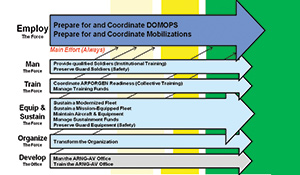
By COL Mark W. Weiss
 In our last edition, I described who we are – first conversely – by destroying a few myths, and then by listing a few stats for our organization. In this issue, I’ll tell you where Guard Aviation is headed and how it will get there…a roadmap to readiness and responsiveness.
In our last edition, I described who we are – first conversely – by destroying a few myths, and then by listing a few stats for our organization. In this issue, I’ll tell you where Guard Aviation is headed and how it will get there…a roadmap to readiness and responsiveness.
Strategic Direction
Our strategic plan’s main effort will always be to accomplish our “dual-mission” – provide competent aviation units to combatant commanders, and provide timely and capable Aviation support to the governors of the 54 states, territories, and District. Everything else we do is subordinate to these two lines of effort. Manning, training, equipping, organizing, and self-development tasks all feed our “Employ the Force” LOE.
Our 5-year goals give us strategic direction. Some of these goals are “sustain” goals that we’ve had over the years – such as “Sustain a 100% success rate at meeting mobilization requirements.” But some of them are one-time goals, such as “Achieve a 10% mishap reduction.” To help provide course corrections along the way, each LOE also has 12-month objectives. Likewise, these include “sustainment objectives,” such as “Sustain 90% duty military occupational specialty qualified (DMOSQ),” and “achievement objectives,” such as “Reach a 65% Fleet Modernization index.”
Throughout the journey, we see ourselves more precisely with quarterly, quantifiable spot-check metrics, such as “domestic operations (DOMOPS) Readiness” (that measures available lift-cargo aircraft and crews) and “Mishap Gradient” (that sees if our trend-lines point downward).
Finally, we use the in-house, State-based Aviation Scorecard to supplement the unit-based commanders Unit Status Report, to better assess our small-unit readiness as these units progress through their Army Force Generation (ARFORGEN) cycles. Our “Block II” Scorecard was just released, and we’re excited about its new logistics module, which will help state Aviation leaders better assess the performance of their aircraft maintenance programs. I’ll give you some feedback on this program later in the year.
Mission Command
The Active Component headquarters (e.g., U.S. Army Forces Command (FORSCOM)) achieves results by directing action through its “span of control,” normally between 3 and 7 subordinate organizations. The Guard’s mission command is more challenging. Since the states, territories, and District report to their governors, and not the ARNG Directorate at Arlington Hall Station, Virginia, our Aviation and Safety Division achieves results by influencing action throughout its incredibly large span of control – 54. To help with this mission command, we employ our State Army Aviation Officer Advisory Council, and its associated Executive Committee. While this technique may sound unorthodox to the Active Component, they are collections of key external aviation leaders who help generate “best ideas” from the field, gain buy-in from the 54, and perform quality control on Arlington Hall staff work. They are immensely valuable and help us “herd the cats.”
As implied above, the ARNG Aviation and Safety Division (ARNG-AV) provides resources, strategic guidance, policy, and staffing assistance to the states, and coordinates with HQDA, National Guard Bureau (NGB), and other governmental agencies in support of the ARNG state and federal mission. Via direct coordination and participation in all facets of the Aviation Enterprise, ARNG-AV serves as the channel of communication to the states, and helps our Acting-Director, MG Judd H. Lyons, achieve the strategic goals of the Army National Guard writ-large. In coming editions of this publication, I’ll lay out a few examples of how this strategy translates into ready, relevant, and competent units – and how these units are excelling at home and abroad.
Finally, let me send out an early invitation. If you attend the AAAA Mission Solutions Summit in Nashville next March, please stop by the ARNG booth. If you’re a Guardsman, we’ll show you a few things you may not know, and help you become a member of Army Aviation’s premier professional forum – AAAA. If you’re not a Guardsman, stop by and we’ll show you why you should be. Fly Safe – Fly Guard.
COL Mark Weiss is the chief of the Army National Guard Aviation and Safety Division located in Arlington, VA.
Caption: Army National Guard Aviation Strategic Direction / ARNG GRAPHIC








